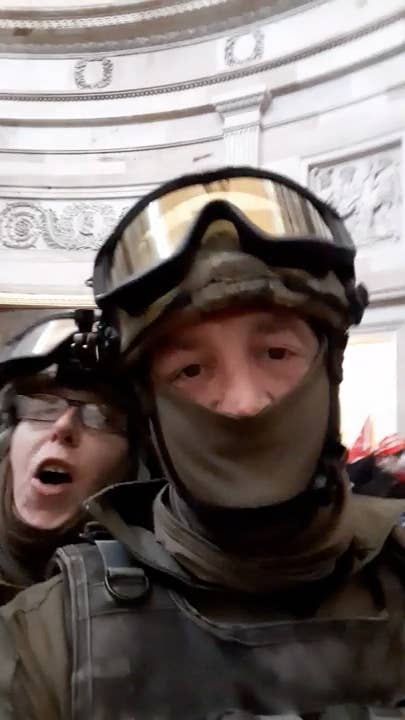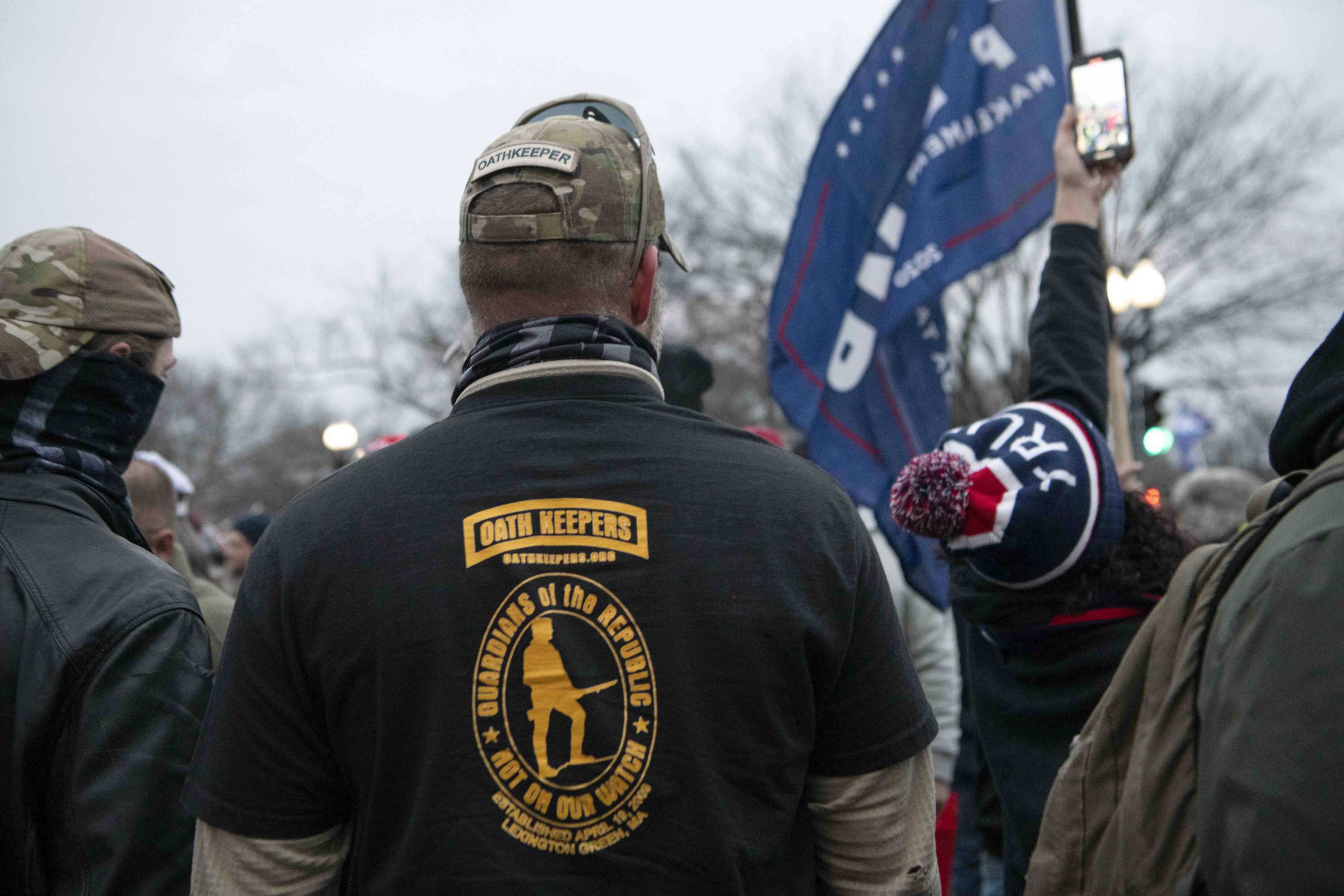Decked out in full tactical gear, Jessica Watkins appeared ready for battle, but her face, peering out from under her ballistic helmet, was jubilant.
“We’re in the fucking Capitol, bro,” she declared, looking straight into a cellphone camera and flashing a victory sign.
Over Watkins’ shoulder, the ornate carvings of the soaring Capitol rotunda dome were visible, and all around her mobs of people who had smashed their way into the hallowed building were milling about.

Watkins, 38, a veteran of the war in Afghanistan who has for the past two years run a bar in the small village of Woodstock, Ohio, is facing some of the most serious charges yet filed from the mob insurrection that left five people dead and sent members of Congress fleeing for their lives early this month.
On Wednesday afternoon, Watkins, along with two others who were with her in the Capitol, Donovan Crowl and Thomas Caldwell, were indicted by a federal grand jury on four charges, including trespassing, obstruction of an official proceeding, and, most seriously, conspiracy to “stop, delay, and hinder Congress's certification of the Electoral College vote” of Joe Biden as president.
What little is known about Watkins has largely been culled from social media and a single interview she gave earlier this month. But her longtime boyfriend, Montana Siniff, gave BuzzFeed News a series of interviews that fill in the blanks on much of her life, and especially the last tumultuous year.
Watkins’ journey from decorated Army vet and well-regarded volunteer firefighter to alleged insurrectionist would seem, at first glance, unlikely. But the forces that propelled her onto the FBI’s radar have become increasingly familiar: a caustic stew of misinformation spread on conspiratorial websites, aggressive boosterism and logistical support from right-wing extremist groups, and the collision of a global pandemic with last summer’s Black Lives Matters protests. As described by Siniff, it all happened very quickly.
Watkins, Siniff said, began 2020 hopeful about the bar she’d rechristened the Jolly Roger, but COVID put her business in a perilous state. As the pandemic wore on and cities across the country convulsed with protests over lockdowns and police shootings of unarmed Black people, she was rapidly drawn into the orbit of the Oath Keepers, which prosecutors describe as a “large but loosely organized collection of militia” whose members believe the government is trying to strip citizens of their rights. Last summer, the small paramilitary group Watkins formed, the Ohio State Regular Militia, was patrolling Louisville amid protests over the police killing of Breonna Taylor. By the fall, she was answering a call from the Oath Keepers to travel to Washington, DC, in support of Donald Trump’s efforts to overturn the election.
On Jan. 6, Watkins penetrated the nation’s Capitol in a bulletproof vest, fatigues bearing Oath Keeper insignias, and goggles to protect her eyes from tear gas. Using an app that allows for radio-style communication, her compatriots cheered her on as she strode through the building.
“Get it, Jess. Do your fucking thing. This is what we fucking [unintelligible] up for. Everything we fucking trained for.”

Watkins is currently detained in the Montgomery County jail in Dayton and could not be reached for comment. An hour’s drive away in Woodstock, her boyfriend rejected the suggestion that she’s anti-government or violent.
“Charges of seditious conspiracy,” said Siniff, his voice breaking. “That’s not Jess.”
Siniff, who is 30 and runs the Jolly Roger bar with Watkins, said his girlfriend is a patriotic veteran and small business owner whose livelihood was crushed by pandemic lockdowns and had started the Ohio State Regular Militia because she wanted to help her community.
She went to Washington, Siniff insisted, not to undermine democracy but to protect people who believed the election had been stolen from Trump and to maintain order during the rally and protests.
Prosecutors clearly don’t see it that way. Justice Department officials announced last week that they had formed a task force of senior lawyers to “build sedition and conspiracy charges related to the most heinous acts that occurred in the Capitol.”
The federal government has accused the trio of planning their crimes as early as Nov. 3, the day of the election and said they used social media and messaging applications to “send incendiary messages aimed at recruiting as large a following as possible to go to Washington D.C.” on Jan. 6.
The indictment also says that on Nov. 9 Watkins sent text messages to a number of people she hoped to recruit to her paramilitary group, telling them she had a training coming up in early January and writing to one recruit: "I need you fighting fit by innaugeration [sic]."
A week later, according to the indictment, Watkins texted a recruit that she did not “underestimate the resolve of the Deep State. Biden may still yet be our President. If he is, our way of life as we know it is over. Our Republic would be over. Then it is our duty as Americans to fight, kill and die for our rights.”
So far, the vast majority of the more than 140 people accused of illegal acts on Jan. 6 face lesser charges, many of them simple misdemeanors. But if convicted, Watkins and her cohorts face years or even decades in prison. Court documents suggest more people could be accused of participating in that plot in the future.
Siniff said he is hopeful the legal system will eventually exonerate his girlfriend of the most serious accusations. But he also said he didn’t feel good about her heading to Washington for the January protest. Things had the potential to spiral out of control, he recalled warning, and he feared she could get injured by police.
“I felt like, in those kind of cities — it’s not Ohio, and you set yourself up for danger with people that don’t really get what you might be trying to do,” he said. “I tried to convince her not to go.”

Watkins decided to form a militia, Siniff said, not because of politics but because of a natural disaster.
By his account, she founded the Ohio State Regular Militia after a string of tornadoes ripped through the city of Dayton in late spring of 2019, wreaking destruction and leaving 80,000 people without power.
Watkins, who had previously worked as a firefighter and EMT in North Carolina, proposed forming a group that could rush in after disasters, provide first aid, protect businesses from looting, and help maintain order. Watkins was the commanding officer, but at that point, the group had only one other member, whom Siniff declined to name and who eventually had to step away because of “family responsibilities.”
Siniff said the goal of the group wasn’t political; it was just to “prevent everything from falling apart.”
“Before 2020, you might have a bad riot once a year, but this has been a crazy year.”
It felt good, Siniff added. “Being prepared for more than oneself, and being able to help other people just feels good. Better than drinking.”
Watkins, who had joined the Army right out of high school in 2001 and completed airborne training before being deployed to Afghanistan, stepped into a leadership role. Drawing on her EMT training, she taught members how to assist people who were wounded. She had worked for the Stoney Point Fire Department in Fayetteville, North Carolina, from 2010 until 2014, first as a volunteer and then as a full-time firefighter and emergency medical technician.
“She had a good work ethic,” recalled the chief, Freddy Johnson Sr. “She got along with everybody.”
In Woodstock, Siniff and Watkins had their hands full running the Jolly Roger.
The pair had met in a card shop in Hilliard, Ohio, playing “Magic: The Gathering.” Siniff worked at a car parts factory and Watkins in retail. The pair purchased the bar in 2018 and moved into the apartment upstairs.
Launching the new business proved difficult; with business slow, they quickly burned through what little capital they had, Siniff said. Watkins tended bar, while Siniff handled supply runs.
The first two months of 2020 seemed promising, with business picking up. Then came COVID-19, and with it, the lockdowns and curfews. On the heels of that came the Black Lives Matter protests, which the couple saw on TV. The couple started to feel, Siniff said, like America was coming apart.
Watkins, according to Siniff, began regularly watching videos on Infowars, the far-right conspiracy-driven website run by Alex Jones. It was there that she saw an interview with Stewart Rhodes, the founder of the Oath Keepers, who has been a regular guest on Infowars for years.
Rhodes, a former paratrooper who later went to Yale Law School, founded the Oath Keepers in 2009. He actively recruits current and former law enforcement and military — people who swore an oath to defend the Constitution — to its membership, which Rhodes has claimed numbers in excess of 30,000.
The group charges members annual dues and has called on local chapters to support operations in numerous hot spots around the nation, including Ferguson, Missouri, in 2014, and the Malheur standoff in Oregon in 2017. Critics of the Oath Keepers, including the Southern Poverty Law Center and the Anti-Defamation League, have labeled it a white supremacist and anti-government extremist group, and Rhodes in the past year has espoused increasingly radical theories, including many aligned with QAnon, such as a desire to expose pedophiles within the “deep state.”
As Black Lives Matter protests began breaking out around the country, Watkins decided to affiliate her group with the Oath Keepers, Siniff said.
Soon, the Ohio State Regular Militia, which never numbered more than a few people, answered a nationwide call from Rhodes to travel to Louisville during protests over the killing of Breonna Taylor, ostensibly to help maintain order.
In late September, Watkins’ small band returned to Louisville to stand guard over a pawn shop, a hotel, and several other businesses that had, Rhodes told reporters at the time, requested their protection in writing. Rhodes did not respond to a request for comment, but Siniff said he and Watkins decided to become dues-paying members. In return, the organization picked up some of their lodging costs while they patrolled Louisville, according to Siniff.
“It just seemed like a crazy time in America,” Siniff said. “Sometimes, you have to be willing to take a stand. You never know what will happen. If things continue to go out of control in one area, you never know what will happen.”
Then came the election. A few days after Trump lost, the Oath Keepers put out a call for members to go to Washington, DC, for Trump’s “Million MAGA March.” Siniff and Watkins made the drive, staying at Caldwell's Virginia farm. Caldwell, according to the Winchester Star, is a retired Navy officer.
Siniff said he did not enjoy the experience. “It felt like we didn’t help anyone. We were supposed to provide security for some of the speakers,” Siniff recalled. But it seemed the speakers didn’t need security, and instead it felt like they were walking around amid “a festival.”
Several weeks later, Siniff said, the Oath Keepers again put out a call for members to come protect people at Trump’s “Stop the Steal” rally on Jan. 6.
This time Siniff stayed behind. Somebody had to tend bar.

Watkins traveled to Washington with Crowl, another member of her militia. Crowl, 50, is an ex-Marine and Jolly Roger patron whose mother later told the New Yorker that his racist, right-wing views and decision to join the capitol riot made her "sick to my stomach."
Watkins posted updates to Parler, a social media platform favored by many right-wing extremists, which was taken down in the furor after the insurrection.
“We made it to DC,” she wrote in one post before the storming of the Capitol, accompanied by a photo of herself beneath a mask. “Spent all day protecting various speakers on the main stage in Freedom Plaza. You are all amazing America! We love you.”
Later posts ultimately wound up in federal prosecutors’ charging documents, such as one video after the insurrection. “Yeah. We stormed the Capitol today,” she wrote. “Teargassed, the whole, 9. Pushed our way into the Rotunda. Made it into the Senate even. The news is lying (even Fox) about the Historical Events we created today.”
Watkins and Crowl returned to Ohio without, it seems, understanding the repercussions of their involvement.
The pair were quickly identified from social media, and Watkins gave an interview to the Ohio Capital Journal in which she explained that she had entered the Capitol but had tried to stop the vandalism and violence once inside.
“To me, it was the most beautiful thing I ever saw until we started hearing glass smash,” she said.
She added: “We never smashed anything, stole anything, burned anything, and truthfully we were very respectful with Capitol Hill PD until they attacked us. Then we stood our ground and drew the line.”
Crowl gave his own interview to the New Yorker, admitting that he had been drinking before picking up the phone but nevertheless continued talking for more than an hour.
Siniff said that as reporters began to descend on Woodstock, Watkins and Crowl skipped town, driving to Virginia to stay at the home of Caldwell, the fellow Oath Keeper who had been in the Capitol with them.
The pair didn’t know it yet, but they had bigger problems than the media.
Federal law enforcement officers were poring through the social media posts from the Capitol and closely reading the interviews Crowl and Watkins had given. They had also obtained an audio recording of communications on the social media walkie-talkie app Zello between Watkins and “other suspected Oath Keepers” during the incursion on a channel called “Stop the Steal J6.”
Early in the storming of the Capitol, prosecutors said a voice they believe to be Watkins’ says: “We have about 30-40 of us. We are sticking together and sticking to the plan.”
A few minutes later, she comes back on the line: “We are in the mezzanine. We are in the main dome right now. We are rocking it.”
On Jan. 16, federal prosecutors obtained an arrest warrant for Watkins and Crowl, as well as a search warrant for Watkins’ home.
The next morning, in the predawn darkness, the FBI descended on Woodstock, banging on the door of the Jolly Roger and setting off what appeared to some observers as flash grenades.
Watkins wasn’t there, but officers roused Siniff and searched the premises, finding numerous firearms, pool cues cut down to baton size, zip ties, and medical supplies, according to an FBI affidavit.
FBI agents also found “what appeared to be directions for making explosives,” authored by “The Jolly Roger.” Siniff insisted Watkins wouldn’t get involved with explosives, because she had seen too many injuries from them in Afghanistan.
After Watkins heard about the raid from Siniff, she and Crowl drove back from Virginia and turned themselves in to the police department in Urbana, Ohio, about 20 minutes from Woodstock. Caldwell, arrested in Virginia, is also in custody. A federal public defender representing him did not return a call seeking comment.
Watkins has been in jail since then and has yet to appear in court. Siniff worries about what will happen if she is convicted, how many years she might spend in prison.
It all seems difficult for him to comprehend. “I don’t think they ever intended to do anything illegal,” he said. ●
UPDATE
This story has been updated to include Wednesday's indictment and details contained in that document.

